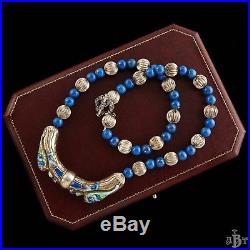
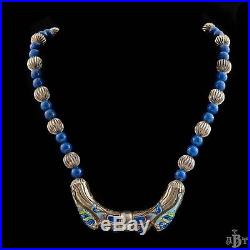

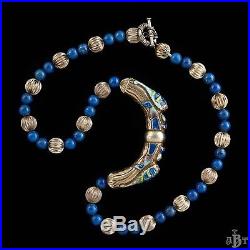
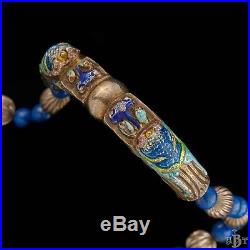
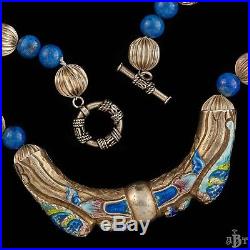
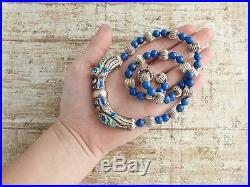

If you like this beaded Chinese enamel dragon necklace, we think you will also like these Chinese enamel dragon bangle bracelets! Age Circa : Art Deco C. Gram Weight : 68.5 Grams. Main Stone : Lapis Lazuli. Main Stone Measurements/Color : 0.3 in diameter, rich swirling blue with golden Iron Pyrite flecks. Accent Stone Measurements/Color. Stone Treatment : The stones appear to be untreated, but we are not certified gemologists and cannot be sure. Stone Cuts : Hand-carved beads. Item Measurements : This necklace has a wearable length of 21. The dragon pendant is 1.4″ long by 3″ wide. Pendant Type : Dragon Bead. This gorgeous bead necklace was completely handmade in China during the Art Deco period, and brought back to Europe as a souvenir by a Grand Tour traveler. It features a curved, tube bead shaped pendant that is done in the Two Dragons Chasing a Pearl motif. The dragon heads and the pearl they are chasing are made out of sterling silver, and the dragons have been expertly chased with scale and feather details. The chasing gives the dragons a bit of added sparkle when the light hits them just right. The faces and crests of the dragons have been accentuated with enameling in beautiful purple, yellow, and light and dark blues. The strand of beads consists of hand carved lapis lazuli beads, whose rich blue color and golden iron pyrite flecks match the color of the enamel on the dragons, bringing unity to the piece. Interspersed station-style between the lapis lazuli beads are larger, scalloped hollow beads made out of sterling silver, adding a sense of bright airiness to the necklace. The beads were all meticulously hand formed and individually strung on a sterling silver wire. The clasp was replaced at one point, and a toggle clasp was added for ease of wear. This breathtaking necklace is an absolutely stunning piece of history that you can wear! Damage : Age appropriate wear. There is some wear on the enamel, but that is not uncommon for a piece this old, and does not affect the beauty of the necklace. This beautiful piece comes from the Art Deco Era! The Art Deco Era is famous for being the “Gatsby” or “Roaring Twenties” Era. A lot of gorgeous and timeless designs in jewelry came out of this period. During the Art Deco Period jewelers often made jewelry upon custom order, this would often take weeks to months to completely craft by hand. The Grand Tour was the standard European vacation of the Georgian and Victorian eras. The opportunity it gave for studying culture, architecture and art made it a tradition, especially for the upper classes. And what better souvenir of this long trip than pieces of native souvenir jewelry such as Italian cameos, mosaic and pietra dura pieces. Pieces often also had historical inspirations from the remnants of Pompeii to the pyramids of Egypt, cultural learning was a focal point of the grand tour, the process of remembrance spilled over into jewelry souvenirs. Chinese export jewelry became popular during the late Victorian Period and lasted until the 1960’s. In a lot of ways, Chinese export jewelry fashioned what we know of jewelry today. During these periods, Chinese craftsmen, including jewelers and stone cutters, were considered by far the best in the world. Chinese Stone cutters were considered some of the finest artisans in the world during the Vintage Era. They would carve western themes as well as the rarer traditional eastern themes into their many pieces. The chasing technique is a very difficult silversmith process when the artist uses a nail-like tool and hammer to hand etch patterns within the metal work. This process was very difficult and only the best jewelers were trained in the process. The Method of Enameling originally dates all the way back to the Ancient Egyptians. The Ancient Greeks, Celts, Georgians, and Chinese all followed suite. The technique involves fusing powdered glass to a substrate, or base, by firing. In jewelry, the base is generally a metal. Enamel is made of colored powdered glass, or may include clear powdered glass that is mixed with colorful metallic pigments. It is primarily used on decorative art or jewelry, usually small in size. Besides jewelry, enamel can also be applied to glass, ceramic, stone, and various other materials. Historians believe the link between humans and lapis lazuli stretches back more than 6,500 years. The gem was treasured by the ancient civilizations of Mesopotamia, Egypt, China, Greece, and Rome. They valued it for its vivid, exquisite color, and prized it as much as they prized other blue gems like sapphire and turquoise. PLEASE WAIT FOR AN UPDATED INVOICE BEFORE PAYING FOR YOUR ITEMS. Thank you for your cooperation. The item “Antique Vintage Deco Sterling Silver Chinese Lapis Bead Enamel Dragon Necklace” is in sale since Sunday, December 17, 2017. This item is in the category “Jewelry & Watches\Vintage & Antique Jewelry\Fine\Art Nouveau/Art Deco 1895-1935\Necklaces & Pendants”. The seller is “abeautifultimeco” and is located in Fort Collins, Colorado. This item can be shipped worldwide.
- Metal: Sterling Silver
- Style: Strand/String
- Country/Region of Manufacture: China
- Main Stone: Lapis Lazuli
- Metal Purity: .925
- Material: Enamel
- Ethnic Origin: Chinese
- Type: Beads
